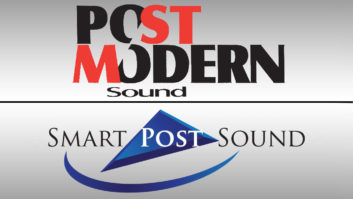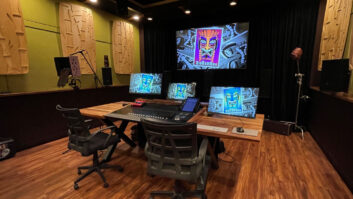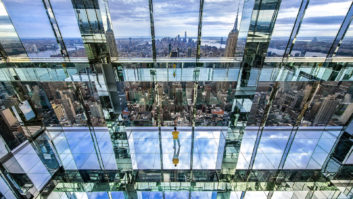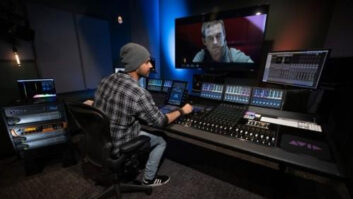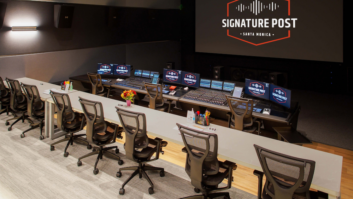It doesn’t take an insider to see that the New York post-production industry is booming. New shops are opening up, commercial mixing facilities are moving south on the island, and everyone seems to be building new rooms. The economy is doing well, and it shows.
This television season has seen a 100% increase in prime-time dramatic and comedy television programming produced in New York, with six new network and pay cable shows joining the six already produced in town. (This is believed to be the largest number of prime-time programs produced locally since the Golden Age of live television in the 1950s.) While many of these new programs will do their audio post in Los Angeles, some are staying in New York, and that is sending a restrained ripple of excitement through the town’s audio post community. Sync Sound is already on board to post the new UPN mid-season police show The Beat from Homicide producer Tom Fontana.
The new New York-based shows include UPN’s The Beat about street cops; CBS’s Now & Again, about a middle-aged man whose brain is transplanted into the body of a twenty-something; NBC’s Law & Order: Special Victim’s Unit spinoff and Third Watch about cops, firefighters and paramedics; ABC’s mid-season entry Bellevue, about the famed psychiatric ward; and Talk to Me, about a radio talk show host.
This big production news is, however, only the tip of the iceberg. The box that brought the country highly regarded live drama from New York in the ’50s has mutated. The networks continue to lose viewers as the cable networks gain them, and original cable programming is (along with commercials) the bread-and-butter for the town’s audio post houses.
While this shift of viewers from broadcast to cable networks has been on the radar screen for a while, the difference lately is that these cable programs have actually become solid successes. That new prominence translates into bigger audio budgets for the shows, as well as for the seemingly endless streams of promotional spots.
Two other recent driving forces have been the proliferation of DVD and surround sound programming. With surround-in-a-box systems available at every discount store and wholesale club, and with DVDs finally approaching the staging area for attaining critical mass, surround mixing has boosted the bottom line of New York’s post facilities.
And then there’s the economy. Any visitor to popular Manhattan neighborhoods, such as the Union Square area or the Upper West Side, will find chic restaurants situated cheek-by-jowl and will likely find most of them jammed at 11:00 p.m. on any given weeknight. The town, like the rest of the country, is booming, and that means more goods to sell to more affluent consumers. And with New York still the center of the advertising universe, that spells plenty of work for audio post houses that specialize in commercials. Many facilities told Mix that the spot business has been quite good this year, and several even said they didn’t see the traditional summer slump in that cyclical segment.
One by-product of the robust economy is that there is money to spend, and everyone seems to be adding rooms, particularly living room-style mix suites with a casual openness that includes windows-you know, the glass variety that look onto the outside world. The reason for this trend is informative. Mix was told, time after time, that there are so many choices among top post facilities that clients are now demanding not only cutting-edge technology but also a comfortable, fun place to work. Imagine that!
Los Angeles still has a firm grip on the glamorous world of feature film post, but when it comes to television audio, New York is still the center of the universe.
HOWARD SCHWARTZ RECORDINGHoward Schwartz virtually invented modern television audio post in New York in the late ’70s, and the elder statesman (he’s 52) is still thinking like a pioneer.
Schwartz says the business is “more competitive than ever,” which is leading to some big changes. “The trend is doing business, by which I mean one can no longer stand on creative ability alone,” he says. “You need client services, technical excellence and creativity, in equal parts.”
In a boom town where clients have lots of options, the one who can “provide a fun atmosphere in which to get the job done wins,” Schwartz says. “The best restaurant in New York is the one where they know your name. The client will call the facility where the staff remembers their name. The old days of ‘I have to work with so and so’ are gone. I can buy the same consoles as everyone else, and so what? At Howard Schwartz Recording, clients are treated like they’re a big deal.”
People also like to associate with success he adds; therefore, they want posh rooms that make them feel like they’re working with the leader. “Threadbare is no longer hip,” Schwartz notes.
Along those lines Schwartz recently expanded into the Smithsonian space on the same floor, adding 10,000 square feet (for a total of 25,000) and 16 post rooms. Schwartz added a new “living room-style” 5.1 room 19 floors above the breathtakingly refurbished Grand Central Terminal. Windows overlook the landmark; in the room is an Avid AudioVision/SSL package. The room also has niceties like multiple plug-in fast Internet connections for clients.
Schwartz did the ADR for the Julia Roberts/Richard Gere film Runaway Bride and still does the audio post for Cosby, which is shot on video at Kaufman Astoria studios in nearby Queens. Other regular clients include Budweiser, HBO and The Simpsons.
Schwartz’s outfit includes SSL consoles, four Avid AudioVision workstations, five SSL ScreenSound workstations with SoundNet networking, AMS AudioFiles, Synclavier Post Pro SDS, Sonic Solutions workstations and Fairlight MFX-3 systems.
SYNC SOUNDSync, one of the longtime leaders in New York television audio post, launched a major initiative into the feature film mixing business in early 1998, building a big, beautiful film mix theater for a sister company called Digital Cinema (Mix, “Post Script,” June 1998) around the corner from its West 56th Street home base. Oscar-winning mixer Rick Dior (Apollo 13) was onboard, and things looked promising. Then tragedy struck with Dior’s unexpected death late last year.
“You can’t replace Rick Dior,” says Sync partner Bill Marino. “There’s no easy fix for the situation.” However, the boom in surround mixing for television and DVD has led to a refocus, at least temporarily, of the posh Digital Cinema facility on high-end television work.
A key addition to the Digital Cinema mix theater is double-stack video projection (in addition to the room’s full 16mm and 35mm capability). “We’ve got two projectors throwing the same video image on our big screen, thereby doubling the brightness,” Marino says, adding that it makes a big difference in the quality of the experience for the client and mixer.
Curtis Drake was hired to supplement the mixing staff, which includes Graham Maxwell and partner/founder Ken Hahn. “Curtis is an expert on the AMS Neve Digital Film Console, which is the centerpiece of Digital Cinema, having worked extensively on the console’s product development team from the operator’s standpoint,” Marino explains.
Tom Fontana’s hour-long police drama The Beat will be posted at Sync, taking up the slack left by the cancellation of NBC’s Homicide: Life on the Street, which had been posted at Sync for years.
The new Fontana show will likely use the Digital Cinema room, Marino notes. “Longform is our focus and will continue to be,” he says, pointing out that Sync does a great deal of work for HBO and MTV networks.
At press time, it was premature to announce some new projects, but Marino expects to land at least one more of the new prime time television projects emanating from New York. “The business climate is good, production is up,” Marino says.
Sync recently added three Pro Tools Mix Plus systems and upgraded its AudioFile editing capability with three 24-bit systems.
SONY MUSIC STUDIOSThe Sony Music Studios post facility, which comprises four rooms, was built (like the rest of the massive complex) to service Sony’s own output. However, it has grown into one of the leaders in the overall New York post community.
At Sony the specialty is music programming and, to a lesser extent, cable comedy and children’s shows. “We don’t go after dramas or sitcoms,” explains John Alberts, a New York audio post veteran and multiple TEC Award-nominee. Music, cable comedy and children’s programming make up 90% of Sony’s post business, he says.
But DVD work is the big news. “We’re very involved in surround mixing for DVD, which has been going strong over the past year,” Alberts explains. They, of course, have done all Sony releases, nearly 40 to date. Projects in-house at press time included DVDs from Natalie Merchant and The Bee Gees.
“We do most of VH1 and MTV prime time programming, as well as a great deal of work for Comedy Central, including mixing Upright Citizen’s Brigade and the voice recording for South Park,” Alberts says. PBS’s Sessions from West 54th, which is shot in the facility’s big sound stage (where, in a much earlier incarnation, scary scenes from the film The Exorcist were shot), is also posted at Sony.
The facility recently made a significant Pro Tools hardware and software upgrade; the company is now running five Pro Tools stations and adding the Pro Tools|24 MIX system with 16 outputs and 64 voices, as well as “every Pro Tools post-production software plug-in available,” Alberts notes. Mixing takes place on Euphonix, Neve and SSL consoles.
The ascendancy of Pro Tools has also presented new competition. “There are a lot of small, single Pro Tools facilities being built,” Alberts notes. “However, it comes down to people; no matter how many people buy the latest gear, there is always a shortage of excellent mixers.”
NATIONAL SOUNDThe big news at National Sound is that Peter Fish, composer and creative director, is no longer with the firm. National’s vice president of entertainment and production, Russell Best, says Fish left in mid-summer after a “long and very creative stint, during which he helped build National Sound into a first-class facility. He wanted to pursue his own ventures. We’ll miss Peter, but we’re actively looking to take National to new heights by restructuring that division under powerful, diverse industry players.”
Business prospects are looking good, as “audio becomes more important each year,” says vice president of technology and engineering Jonathan Applebaum. “Television used to be a throwaway; people would leave an online suite with a documentary-style program and say, ‘We’re done!’ Now, more and more people are going from the Avid room to a mix facility, and this is, of course, a necessity with surround mixing.”
As evidence of the greater importance of television audio to consumers in the real-world environment, Applebaum notes that he is seeing mix rooms being designed without the traditional tiny Auratone speakers for single-speaker/small speaker TV reference. “With the growth of easy-to-use surround home systems, overall, consumer’s speakers have improved, which is truly great news for facilities such as ours.”
National mainly handles a mix of long-form, promotional and PBS work, with a bit of broadcast and cable network business. Clients include Nature from PBS, VH1 and MTV promos, A&E longform and promos, and Lifetime, Nickelodeon and ESPN promos. The facility has five mix suites for sound to picture, three prelay suites, as well as two each for music composition and music/sound effects search, and one duplication room.
New gear includes three 5.1 Euphonix consoles added in the past 18 months, with one new room featuring the recently popularized living-room-with-windows configuration. “The days of the dark, windowless room with only task lighting are coming to an end,” says Applebaum. “Our windowed room has natural wood trim and an open, homey feel. If you’re going to spend eight to 16 hours in a room, you might as well be comfortable.”
National handles sound editing and mixing and has networked the facility so that editors and mixers can share the data files. The company also has divisions called 101 Original Music, which composes and records television music, and Those Music Babes, a team that creates fresh-sounding music on a budget from library material.
NEW YORK MEDIA GROUPSurround sound is booming at the audio post-production divisions of the New York Media Group, which includes Superdupe Recording, Mixed Nuts, East Side and Lower East Side.
Nine of the various divisions’ 16 post suites are equipped to handle the complex mix requirements of multichannel work. “Surround is being driven by the boom in home theater systems,” says Piers Plaskitt, marketing director for NYMG. A recent high-profile project was the surround audio for the DVD release of the Oscar-winning film Sense and Sensibility.
The facility, now in the process of updating each of its rooms one at a time in a rotating cycle, recently completed a new John Storyk-designed living room-style surround suite at its Lower East Side operation. “The new room is a bit like visiting a downtown loft that has a studio. No one wants to be locked in a dark room without windows anymore,” Plaskitt says.
The New York Media Group has made a huge commitment to Soundtracs DPC II consoles with a total of eight throughout the various divisions: Five are at Superdupe, two at Lower East Side and one at East Side. That facility also recently obtained four Fairlight MFX-3 systems and a Fairlight Media Link network.
Superdupe is beginning its second season of doing the audio post for ABC’s popular Spin City and expects to be posting at least one more of the six new network prime time shows now in production in New York.
The Spin City assignment is notable because that task includes laugh sweetening, which has always been a solidly West Coast business. “We convinced DreamWorks we could do it here,” Plaskitt says proudly.
Also, the DVD business has exploded, making it one of the busiest summers ever and helping to compensate for the summer slowdown in spot work.
AROUND TOWNBusiness has been good at Soundhound, which handles a mix of spots and cable network promotion. “The cable promo world is a staple in New York, and it is a 12-month-a-year business,” says owner Gail Nord.
The facility also does a lot of work on new narration and M&E tracks for longform cable network programs. “The cable nets buy programs from overseas and redo the narration in English, or English without an accent, or rewrite narration to update the piece,” Nord explains.
Soundhound has six studios, all with digital picture capability, mainly using Pro Tools|24 with Pro Control. Studio D uses Doremi V1 digital video for random access.
A new 5.1 room is expected to be open this fall. “We took down a studio and built a living room-style facility,” Nord says. “It’s high-tech with a low-tech feel. There’s no separation between the producer and mixer.” Soundhound expects to add two new rooms in 2000 by acquiring more space in its current building; however, plans are not yet final.
Pomann Sound specializes in cartoon work and spots. The success of the company’s work on Nickelodeon’s hit Doug has led to post assignments for the new show Courage the Cowardly Dog for Cartoon Network, Little Bill, the new Bill Cosby tooner from Nickelodeon, and the new PB&J from Doug’s producers for the Disney Channel.
“The influx of longform work we’ve been getting helps even out the ebb and flow of the agency work,” says Darryl Jefferson, studio manager.
Pomann is planning a new studio with a 24-bit DSP Postation editing/mixing system, bringing the room total to six. “The new DSP will give us more speed and flexibility and more powerful editing capabilities. It’s the cutting edge,” Jefferson says. The room should be operational in early 2000.
Broadway Sound, a division of Lorne Michaels’ Broadway Video, is currently doing audio mixing and sound design for Noggin, a new Nickelodeon network, specifically for a live action and animated longform show called Phred on your Head. Broadway is also posting all of Noggin’s on-air promotional spots.
The team of Ralph Kelsey and Michael Ungar is also doing work for Showtime Networks, mostly with an image campaign for the new venture Showtime Beyond. Several small, independent feature films have also been mixed there recently.
Broadway has four post rooms; Studio 4 was added in the last 18 months and was specifically designed to handle longform programming. There are plans to expand the facility, including the purchase of two new digital consoles, but nothing had been solidified at press time.
